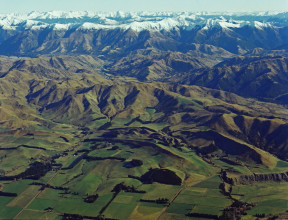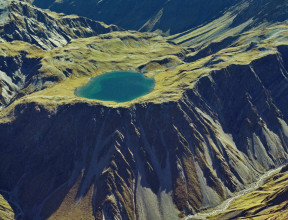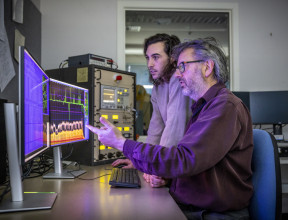
Earth's Magnetic Field

The Earth’s self-sustaining magnetic field is caused by motion of the liquid core of the Earth.
The GNS Science geomagnetics team measures and monitors the magnetic field in our part of the world, making an important contribution to understanding the magnetic field of the globe.
What causes our magnetic field?
Motion in the liquid core of Earth produces a self-sustaining magnetic field. Earth has a solid inner core, a liquid outer core, both with a composition more of metal (mainly iron) than rock, and a rocky mantle, all below a thin crust. Energy from radioactivity travels outwards as heat, producing thermal convection in the core. This convection is the cause of Earth's magnetic field.
Why study the magnetic field?
Earth’s magnetic field extends several tens of thousands of kilometres into space, and protects us from the effects of solar wind, which contains charged particles that would otherwise strip away the ozone layer that protects Earth from ultraviolet radiation.
Geomagnetics teams across the globe measure and monitor the magnetic field to provide “Space Weather” warnings of solar disturbances and forecasts of magnetic conditions such as magnetic storms that sometimes affect communications, electric power, and other human activities. Measuring and monitoring the magnetic field also provides reference information for various kinds of magnetic surveys.
-
Variations in the magnetic field
Earth's magnetic field is unstable. Magnetic variations over the surface of Earth consist essentially of short-wavelength variations (< 200 km) due to surface rocks, and long-wavelength variations (> 5000 km) due to the main field of Earth.
Over a long period, the average positions of the magnetic poles coincide with the geographic poles, but they wander significantly and the two magnetic poles are not at directly opposite positions on the globe. There is also evidence of global magnetic reversals; at intervals that are usually of hundreds of thousands to millions of years, the North and South magnetic poles interchange.
-
The impact of the Sun
Slow changes of Earth’s magnetic field are caused by changes in the core. Rapid fluctuations are due to the particles and electromagnetic waves from the sun.
Short-period magnetic variations were first observed in the Eighteenth Century, by observing a compass needle with a microscope. It was soon realised that there was a fairly regular daily variation, and also occasional larger irregular variations. These irregular variations were found to coincide with the occurrence of auroras.
By the Nineteenth Century, it was realized that both phenomena followed the occurrence of disturbances on the sun, with a delay of about 18 hours between the observation of a solar flare and the related aurora and magnetic field disturbances. This indicated that something was travelling at a speed greater than 1000 km/s from the Sun to Earth which disturbed the magnetic field as it arrived.
In the early Twentieth Century, it was realized that a cloud of ionized particles would act as a conductor. As such a cloud approached Earth, the interaction between the moving conductor and the static magnetic field would produce circulating currents, producing a variable magnetic field. Our models of these upper atmospheric processes have improved greatly since satellite observations began in 1958.
-
Declination around New Zealand
Declination is the difference in horizontal angle between magnetic North and true North. This angle varies with time. Geomagnetic models show the declination around New Zealand. These models include an estimate of how the field is changing with time. Every 5 years a new model is calculated using the latest information (including international geomagnetic models and New Zealand magnetic data).
New Zealand’s Magnetic Observatories
The description of the magnetic field requires measurements spread around the globe. Increasingly, long-term variations are studied by satellite observations, but fixed observatories are essential for studying rapid changes.
GNS Science currently runs a magnetic observatory at Eyrewell, north-west of Christchurch, and at Scott Base in Antarctica. GNS Science also supports the Apia magnetic observatory in Samoa, which is run by the Samoan Government, with assistance from New Zealand and other countries. These observatories provide measurements of the three components of the magnetic field every second, with data telemetered every few minutes. As a quality check, independent instruments measure the total magnetic field strength every second at each observatory.
Magnetic data from these observatories is sent to INTERMAGNET, an international organisation that archives and disseminates magnetic observatory data. The observatories in New Zealand and Samoa provide the only continuous data from about a 90° arc of the Southern Hemisphere, one eighth of the globe. Their continuing operation is essentially a contribution to the world scientific community.


